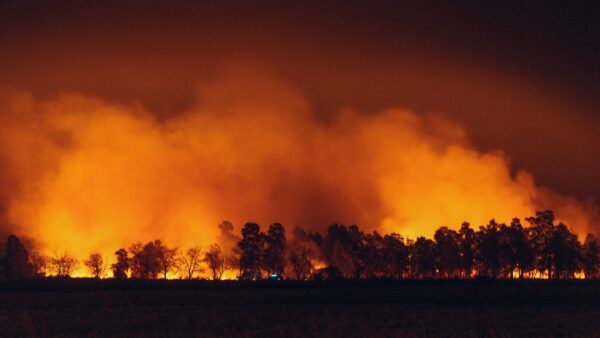Congressional Leaders Letter
A letter to the US Senate and Congress from leading US scientists and Climate Analytics' Bill Hare.
Share

Dear Madame Speaker, Leader Boehner, Leader Reid and Leader McConnell:
Recent statements by political leaders in Congress and the Administration indicate that climate change policy will be a top priority this year. We commend you for your focus on this critical issue, as every year we delay action on climate change brings greater risk of disruptive events and increases the challenge before us. In all aspects of this issue, leadership by the United States is needed, essential, overdue and urgent.
We were encouraged to see the Presidential Memorandum to Heads of Executive Departments and Agencies that affirmed the Obama Administration’s commitment that policy decisions will be informed and guided by science and the scientific process. If ever there was a policy issue that has been subject to a well-established scientific process, including significant peer review, it is climate change and the process under the Intergovernmental Panel on Climate Change (IPCC). We write to urge you to ensure that climate change legislation is informed and guided by the results of peer-reviewed science.
As scientists who have studied climate change for decades, we know that there are major questions Congress will have to resolve in constructing a plan to meet this challenge. Our role in this process is to help you understand the magnitude of the risks we face, while your challenge is to determine how much risk we as a nation choose to accept, what actions America should take to protect itself, and what cooperative and fair agreements America should make with other nations that would be both victims of climate changes and are at the same time major producers of greenhouse gases—China and India as the most prominent examples. Consistent with our responsibilities as scientists, we want to provide you our views on several key elements of a legislative response to the climate threat in the areas of mitigation, adaptation and development of better projections and information for decision makers.
The recent Fourth Assessment Report by the IPCC (AR4) reveals that warming of global mean temperature by 2 or more degrees C above 1990-2000 levels would result in an increasing number of key impacts at all scales, such as widespread loss of biodiversity, decreasing global agricultural productivity and commitment to widespread deglaciation of the Greenland and, possibly, the West Antarctic ice sheets. Limiting warming to less than a few degrees C above pre-industrial temperatures, as discussed in AR4, would involve: 1) near-term emission targets that lead to a peak in global CO2 emissions by 2020; 2) adoption by government of policies that result in significant and immediate investment for deployment of low and zero carbon technologies; and 3) long-term targets that allow for stabilization of global temperatures at levels that prevent many of the worst impacts of climate change.
Global warming is unequivocal.
The IPCC reports state that there is unequivocal evidence that the climate system is warming, that human-caused emissions of greenhouse gases are very likely the cause of most of the warming in at least the second half of the 20th Century, and that climate changes and impacts are now being observed on at least six of the seven continents. Significant data since AR4 indicates that some of the IPCC’s findings may be conservative since there are now stronger reasons for concern based on recent observed impacts of climate change, and the observation of warming on the seventh continent, Antarctica. In particular, Arctic sea ice is retreating and thinning faster than predicted, the Greenland Ice Sheet is melting, ice loss is accelerating from the West Antarctic and sea levels are rising faster than predicted, the natural carbon sinks are decreasing, and GHG emissions since 2000 are close to the highest IPCC scenario range.
One of the important messages to come out of AR4 is that the longer we delay making significant reductions in greenhouse gas emissions, the harder it becomes to limit warming to less harmful levels, and the higher the risk becomes for irreversible impacts on vulnerable systems like polar ice sheets, low lying coastal areas, sub tropical dry zones and threatened species. Limiting overall warming to less than 2°C above pre-industrial levels would likely avoid the most severe impacts of climate. While uncertainties are substantial, IPCC findings indicate that the risk rises rapidly around this level of warming. We can expect global impacts to include increasingly severe threats to water availability for billions of people, change in disease vectors causing a substantial burden on health services globally, millions of people at increased risk of coastal flooding each year and severe impacts on nature including widespread coral reef mortality, high rates of species extinction and extensive damage to ecosystems. The risk of threshold events also increases markedly, including a long-term commitment to several meters of sea level rise due to melting ice sheets, potential disruption of important circulation patterns in the Atlantic Ocean, and a threat of species extinctions on a massive scale. Examples of such changes are already taking place in ecosystems (including bleaching of coral reefs with increasing frequency and large scale tree mortality in coniferous forests as native pine bark beetle go unchecked in warmer winters), and, unfortunately, species and ecosystems are particularly sensitive to climate change as they lack capacity to adapt to large or fast changes. An increase of 2 ̊C above pre-industrial levels greatly increases the probability that the biological underpinnings of our society will be seriously disrupted.
Climate legislation can reduce risk.
To ensure that the American public receives a return on the significant investment needed to mitigate climate change, the level of emissions reductions required in legislation must be sufficient to actually reduce the risks. Furthermore, the more we do – as the world’s historical largest emitter the more we will be able to ask and demand of other nations. Congress must set emissions reductions targets after considering the likely impacts of various levels of warming, the greenhouse gas concentration levels likely associated with such warming, the degree of emissions reductions likely needed to achieve those greenhouse gas concentration levels, and the relative level of action by the US needed to give leverage in negotiations with other countries. In this context we need to learn from international experience: U.S. leadership is critically important; in fact, it remains indispensible, as it has been at other times in recent history.
IPCC’s Working Group II provides significant information about likely impacts at various levels of warming that can inform Congress’ ultimate decision about the level of warming Americans would deem unacceptable. This will in turn give guidance on the greenhouse gas concentration levels that will provide an “acceptable” probability of staying within those warming limits and the corresponding emissions reduction targets. Although the report endorses adaptation activities aimed at coping better with climatic changes that remain mitigated, it also notes the need to mitigate those changes for which adaptation is unlikely to be viable—these accumulate above another degree or two Celsius of warming from today’s temperature.
The IPCC’s Working Group III has already done some analyses of emissions pathways that could limit warming to about 2°C above preindustrial. In these scenarios developed countries as a whole reduce their greenhouse gas emissions to 25-40% below 1990 levels by 2020 and 80-95% by 2050, while developing countries simultaneously slow their emissions growth and ultimately reduce emissions, first in regions that are experiencing the greatest growth but ultimately in all regions. Given its increase in emissions since 1990, the U.S. would need to reduce current greenhouse gas emissions by at least 35% by 2020 to fall within the 25-40% range. We recognize that this aspirational goal to “avoid dangerous human interference with the climate system” would have been easier to attain if we had begun in earnest to achieve this goal when the U.S. ratified the United Nations Framework Convention on Climate Change in 1992, but any further delay will both dramatically increase costs and reduce the likelihood of averting many severe but preventable impacts.
Successful mitigation strategies require that Congress focus on both immediate emission reductions and long-term stabilisation goals.
Unlike conventional air pollutants, carbon dioxide and most other greenhouse gases have a long life in the atmosphere. This means that emissions many decades ago greatly affect today’s atmospheric concentrations of greenhouse gases and likewise our business-as- usual actions now would lock in dangerously high concentration levels for decades to come. Therefore, it is essential that we start to reduce emissions immediately. For every year we fail to control emissions, the challenge of stabilization and risk management is likely to get harder and more expensive. While near-term emission reduction targets are the only way to preserve the option of limiting warming to 2o C or below, or any other long-term climate protection goal, it is also important to define such goals, based on political decisions as to the climate changes we as a nation choose to reject as “too risky”. Strong action now would give us more wiggle room to deal with any adjustment to the long-term goal that may become necessary as our scientific understanding advances. In contrast, further delay would lock us into crisis management.
While emissions targets are essential, they are by no means enough to guarantee results — a comprehensive approach will greatly increase chances of success.
While the global economic crisis and energy security are major concerns for Congress in the coming year, current efforts around an economic stimulus package provide an opportunity to make progress on climate change issues if a significant portion of the investment goes toward putting in place much needed infrastructure that relies on low carbon technologies. The flip-side is also true – large scale infrastructure investments that lock in future carbon emissions will make progress on climate change much more difficult. Therefore, we urge that you seek win-win approaches to solving our economic, energy security, and climate change crises simultaneously. It has been said that “a crisis is a terrible thing to waste”, so we now have a historic opportunity to act as America so often has in history when crises loomed – decisively and fairly.
There is overwhelming evidence that energy policies are of critical importance to the development of alternative technologies or lack thereof. To meet the tremendous technology development and deployment challenge that climate change poses, technology development must be elevated to many times its historical levels. Inclusion of significant funding for research and demonstration of alternative technologies for energy generation and end use in the stimulus package is an example of the type of win- win strategies mentioned earlier.
While all levels of stabilization assessed by IPCC can be achieved by deployment of a portfolio of technologies and practices that are either currently available or expected to be commercialized in coming decades, this transition will not happen automatically. It is essential that we put in place appropriate incentives for development, acquisition, deployment and diffusion of low carbon technologies and more efficient end uses of energy in order for this to occur. These incentives may be embodied in carbon cap and trade legislation, but they will also need to be integrated into broader development policies, regulations, standards, tax policy, financial incentives, voluntary agreements, international treaties, and research, development and demonstration project funding. They must also be integral to foreign policy and the engagement of other countries in international climate agreements through incentives and penalties for failure to reduce emissions.
Our understanding of the climate system will continue to grow and change and our response policies should retain the flexibility to reflect new understanding.
Climate change is complex and is not the sort of problem that we can solve in all its myriad aspects, though considerable progress is likely. Adaptive and flexible approaches are vital. Our knowledge of climate science, impacts, and mitigation will continue to grow over coming years and it is essential that legislation have a built-in process to evaluate our policy approaches in light of new scientific knowledge and social acceptance of various strategies, and change course when necessary.
Adapting to changes in the climate system will be essential and further disruption is likely if comprehensive planning and real adaptation investments are not in place.
Already major disruptions have occurred through climate extremes that likely would not have occurred, or would have been much less intense, absent the buildup of the greenhouse gases. The clearest example is the heat wave in Europe in 2003 that led to loss of some 50,000 lives. But wildfires in California in 2008, the Mississippi floods of 2008, and the wild fires and heat waves in Victoria, Australia in 2009 each provide examples of climate extremes that may have been exacerbated by the global trend. Furthermore, no matter its cause, Hurricane Katrina provided a vivid and unfortunate demonstration of the limits of our ability to adapt to such extremes. No individual events are proof of global warming, but their accumulated increases are strong evidence of increasing impacts from climate change. With proper planning, the effects of all of these events could have been substantially alleviated. Further assessments of vulnerability and possible impacts of climate change in local regions, and development of coping strategies and planning through improvement of building codes, coastal management, and water distribution systems and other infrastructure are essential.
Adapting to changes in the climate system requires science and information
To improve information for decision makers it is essential to address the shortcomings in our observing systems and build even better climate models. We need to build a stronger system based on observations to inform decision makers about what is happening, and why, and what the predictions are for the future on several time horizons. We need to make true predictions of regional climate for years to decades ahead to enable improved planning for climate change and to provide a sound basis for the hard investments required for adaptation measures.
The role of science is not to prescribe a “best” decision, but to provide information about the alternative outcomes of alternative policies. In this case there is a great deal of information within the IPCC report—and parallel reports from the U.S. National Academy of Sciences – that Congress can rely upon to evaluate the efficacy of various approaches and put decision making on a firmer scientific basis. For such complex systems problem, we will never have complete information, but legislation nearly always requires judgment in the face of uncertainty associated with high risks – and climate change is no exception. Half a century ago Justice Louis Brandeis said, “not to decide is to decide”. Taking no action in the guise of lack of perfect information, is itself a decision — one that will have real world consequences for human and natural systems for centuries. It is beyond time to act decisively, and we hope that Congress will take bold action to address this threat and take advantage of opportunities before options are rapidly foreclosed and dangerous impacts become inevitable.
Sincerely,
Dr. Stephen Schneider *
Melvin and Joan Lane Professor for Interdisciplinary Environmental Studies
Stanford University
Dr. Thomas Lovejoy
Biodiversity Chair
The John Heinz III Center for Science, Economics, and the Environment
Dr. Michael Oppenheimer *
Albert G Milbank Professor of Geosciences and International Affairs
Princeton University
Dr. H. Ronald Pulliam Regents Professor Emeritus
University of Georgia
Dr. Kevin Trenberth *
Head of the Climate analysis Section National Center for Atmospheric Research
Dr (h.c.). Bill Hare *
Potsdam Institute for Climate Impact Research
• IPCC Convening Lead Author or Lead Author for AR4
cc: Senator Jay Rockefeller, Senator Barbara Boxer, Senator Jeff Bingaman, Senator Max Baucus, Senator John Kerry, Senator Diane Feinstein, Representative Bart Gordon, Representative Henry Waxman, Representative Charles B. Rangel, Representative Nick J. Rahall, II, Representative Howard L. Berman, Representative Silvestre Reyes











